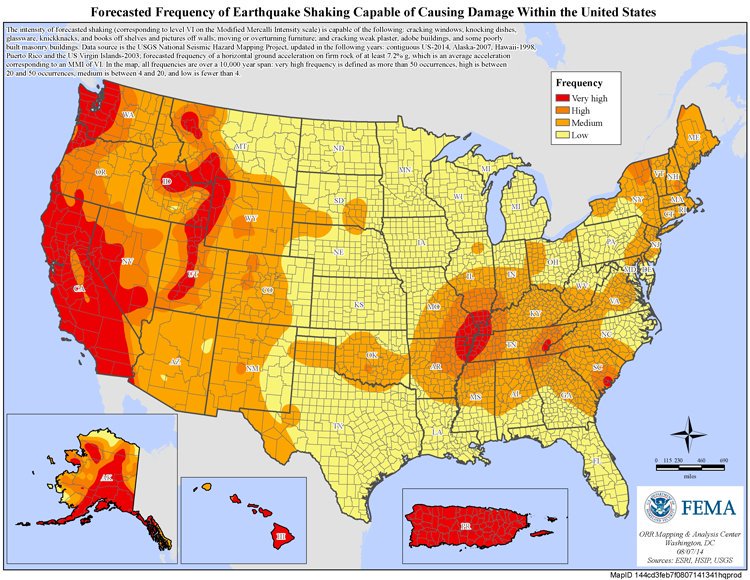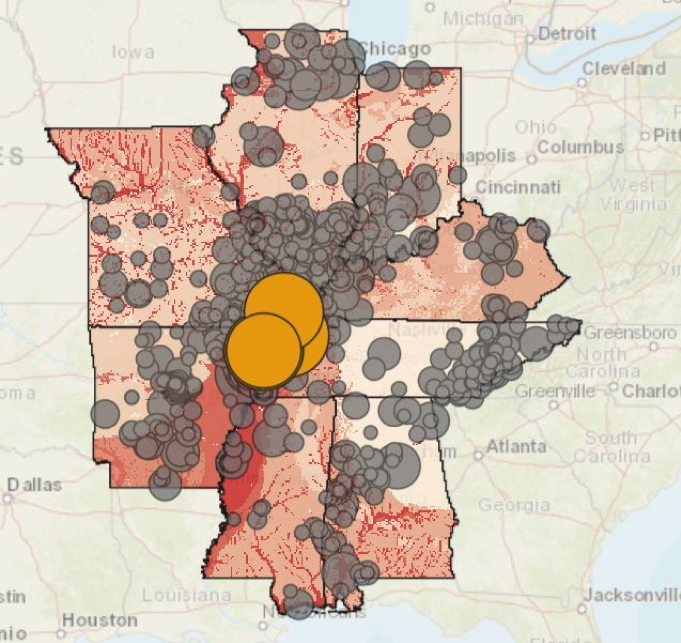By Glynn Cosker
Managing Editor, EDM Digest
California saw its two biggest earthquakes in decades this month when a magnitude 6.4 quake hit on July 4 near Ridgecrest, Calif., followed by a magnitude 7.1 quake just a day later in the same region. Remarkably, and thankfully, the destruction from the two quakes was minimal – and, even though they left a crack in the Earth that is visible from space, nobody died.
Start an Emergency & Disaster Management degree at American Military University. |
Despite California’s penchant for major earthquakes – and the buzz about if and when the ‘big one’ will strike the state, the two quakes near Ridgecrest were mere ripples compared to what might occur in the future – in Missouri and bordering states.
Mitigation and preparedness are vital components for dealing with any earthquake or other disaster situation, and while Missouri is more than ready to take on a tornado or a flood, most Missourians are woefully unprepared to face a devastating major earthquake. And some experts believe that the region – which suffered a series of comparable quakes 200 years ago – is due for another ‘big one.’
The New Madrid Seismic Zone
The New Madrid Seismic Zone (NMSZ) is a series of converging earthquake fault lines that stretches for 150 miles, encompassing the boothill of Missouri – along with regions of western Tennessee, southern Illinois, northeastern Arkansas and western Kentucky. A seismic zone is a group of deficiencies or cracks below the Earth’s surface, where plates shift and cause earthquakes. This map from FEMA shows the most vulnerable regions of the United States.

As the map illustrates, the NMSZ is the most active seismic area in the country east of the Rocky Mountains. In fact, some of the strongest earthquakes in recorded U.S. history have struck the region.
Major Quakes Affected Missouri in the 19th Century
On Dec. 16, 1811, an earthquake with an estimated magnitude of 7.7 struck in the NMSZ – its epicenter was in northeast Arkansas, but it greatly affected Missouri and other states. This quake caused the Mississippi River to temporarily flow backward.
On Jan. 23, 1812, a quake with an approximate magnitude of 7.5 struck, and its epicenter was in the boothill region of Missouri.
On Feb. 7, 1812, a magnitude 8.0 quake struck with an epicenter in New Madrid, Mo.; then, in 1843, the NMSZ endured a magnitude 6.0 quake, followed, in 1895, by a magnitude 6.6 quake. Additionally, experts believe that earthquakes, comparable to the 1811 and 1812 events, occurred in the same region in the 10th and 15th centuries.
Numerous smaller quakes have hit near the NMSZ since 1895 – and there is a possibility of larger quakes in the future. In fact, the U.S. Geological Survey (USGS) issued a factsheet stating that there is a 7 to 10 percent chance of a quake with a magnitude of 7.4 to 8.0 in the NMSZ by 2059, and a 25 to 40 percent chance of a magnitude 6.0 quake within the same timeframe.
Liquefaction – A Major Concern in the Midwest
One of the biggest concerns following a possible major quake, in and around the boothill of Missouri, is liquefaction. Liquefaction, which occurred after the 1811 and 1812 earthquakes, is the result of normally strong sediments losing their ability to carry weight – which turns otherwise robust swaths of land into a runny mixture of sediment and water.
Any major quakes in California and Alaska do not result in liquefaction because the ground in their seismic zones is mostly rocky – and those rocks and nearby mountain ranges absorb most of the shockwaves. The Midwest, however, has mostly loose, granular and moist soil – characteristics that help carry shockwaves effectively after an earthquake.
For example, the 1811 and 1812 quakes caused major landslides along tall bluffs and hillsides; huge swaths of land were permanently uplifted, while other even bigger areas caved downward and were submerged in the water that spouted out of fissures and newly formed craters. Some of the higher banks of the Mississippi River collapsed into the water and some islands completely disappeared.
Quakes ‘Changed the Geography of the Region’
On a recent podcast with KMBC News anchors Haley Harrison and Stephen Albritton, Missouri Earthquake Program Manager, Jeff Briggs, said, “What we know is that the damage in the epicenter, which is right there in the heart of where it happened in the bootheel, was so enormous that it completely changed the geography of the region.” An example of this is the huge Reelfoot Lake in Tennessee – which was created because of the quakes.
Briggs went on to say, “The damage was so severe that it actually made the land sort of rise up in a spot, created waterfalls in the Mississippi River, temporarily made the Mississippi River run backward for that region, and it diverted the water from the Mississippi to a low-lying area in western Tennessee.”
The early 19th-century seismic activity occurred in an area of approximately 100,000 square miles – from Cairo, Ill., to Memphis, Tenn., and from northeastern Arkansas to Chickasaw Bluffs, Tenn. That part of the United States had few residents at that time, but today there are approximately 45 million people in the region.
“There are a whole lot of people living in southeast Missouri, and in large cities near there, most specifically St. Louis, Mo., and Memphis, Tenn., which would get a lot of damage from a big quake like the one 200 years ago,” Briggs stated.
Listen to KMBC’s podcast:
Missouri Emergency and Disaster Management Quake Preparedness
Missourians are accustomed to receiving alerts telling them to expect a tornado, thunderstorm, flood or another dangerous weather situation. There is, of course, no warning preceding an earthquake, which makes the preparedness element of emergency and disaster management extremely vital.
Most people are injured during an earthquake by falling debris and objects within their homes, schools, offices, or other buildings. Emergency and disaster personnel recommend securing all ceiling fans and light fixtures and making sure that heavy objects aren’t stored on a shelf up high in a room.
Another recommendation is securing water heaters in the home by strapping them to a solid structure like a wall stud. After a major quake, the spillage of 40 gallons of water would create an expensive and dangerous mess. Citizens can avoid that mess by taking precautions and – by doing so – will also have 40 gallons of clean drinking water if the quake takes out utilities or makes travel impossible.
It’s also important for people to: identify the safest – and most dangerous – areas of each room; know how to shut off utilities; check the stability of the foundation of a home or other building; and buy earthquake insurance.
EDM officials also recommend a full emergency preparedness safety kit for all people near the dangerous earthquake zone. The kit should include a large supply of bottled drinking water (preferably a clean, empty garbage can full of bottles), canned or dried non-perishable food, a can opener, batteries, flashlights, first aid supplies, a battery-powered radio, appropriate clothing and blankets.
Drop, Cover and Hold On
If a big quake strikes, EDM personnel recommend the practice of “Drop, Cover and Hold On.” The Missouri Department of Public Safety’s State Emergency Management Agency (SEMA) earthquake preparedness instructions states that – in most situations – you will lessen the chance of serious injury or death if you:
“DROP down onto your hands and knees (before the earthquake knocks you down). This position protects you from falling but allows you to still move if necessary.”
“COVER your head and neck (and your entire body if possible) under a sturdy table or desk. If there is no shelter nearby, only then should you get down near an interior wall (or next to low-lying furniture that won’t fall on you), and cover your head and neck with your arms and hands.”
“HOLD ON to your shelter (or to your head and neck) until the shaking stops. Be prepared to move with your shelter if the shaking shifts it around.”

SEMA’s instructions also recommend the following post-quake actions:
- Check for injuries.
- Be prepared for aftershocks.
- Wear sturdy shoes in areas covered with fallen debris and broken glass.
- If the electricity is out – use flashlights or battery-operated lanterns. Check the main utility panel.
- If you smell gas or hear a hissing sound – open a window and leave the building. Shut off the main gas valve outside the building.
- If water pipes are damaged – shut off the water supply at the main valve.
- Check your home and chimney for structural damage.
- Check household appliances for damage.
- Clean up spilled medicines, bleaches, gasoline and other flammable liquids.
- Do not flush toilets until you know sewage lines are intact.
- Open cabinets cautiously because objects may fall off shelves.
- Use the phone only to report a life-threatening emergency.
- Listen to news reports for the latest emergency information.
90,000 Casualties and 700,000 Damaged Buildings
SEMA’s list of earthquake preparedness resources, including what to do before, during, and after an earthquake, is incredibly important. In fact, SEMA’s list should be mandatory reading for all Missourians – especially those in or near St. Louis and those living in or near the boothill, and here’s why.
If a quake similar to the 1811 and 1812 quakes occurred near the NMSZ today, a report by the University of Illinois and Virginia Tech stated that there would be close to 90,000 casualties (including around 3,500 deaths), more than 700,000 damaged buildings. More than seven million people would be left homeless. The resulting economic loss is estimated at $300 billion.
The report also predicts approximately 130 damaged hospitals, along with “extensive damage, and substantial travel delays in both Memphis, Tenn., and St. Louis, Mo.” Such delays would hamper “search and rescue as well as evacuation.” Additionally, the report states that approximately 15 major bridges would become unusable.
The following map from the United States Geological Survey illustrates why the NMSZ is a major concern for emergency and disaster management agencies in the area. (Images courtesy of ArcGIS/USGS)
‘Unprecedented Damage’ To Critical Infrastructure
Adding to the concern, most buildings and other structures in the zone were not built to withstand a major quake, and utilities and communication channels would almost certainly fail.
According to another published report by Missouri University of Science and Technology, a quake greater than magnitude 6.5 “could cause unprecedented damage to the American Midwest, because the region is crisscrossed by numerous pipelines, commercial transportation corridors, power transmission grid network, telecommunications networks, and so forth.”
The same report goes on to state that some of the affected critical infrastructure would include: “buried oil, gas, coal slurry, water, and sewer pipelines crossing flood plains; high voltage (tall tower) transmission lines crossing flood plains; power plants situated along major river channels; water treatment and sewage treatment plants along channels; and underground storage tanks.”
The ‘Big One’
California is always in the public conscious in terms of earthquakes … and, no, there is no chance that the state will become an island if or when the ‘big one’ hits. However, the possibility of a ‘big one’ hitting America’s heartland – and causing the Mississippi river to run backward again – is frighteningly real; the worst-case scenarios for Missouri and its bordering states paint a scene right out of an apocalyptic movie.
Unfortunately, if history is a solid precursor, it is not a matter of ‘if’ a major, devastating earthquake will strike the Midwest, it’s a matter of ‘when’ it will strike.
Everyone should be ready.



Comments are closed.